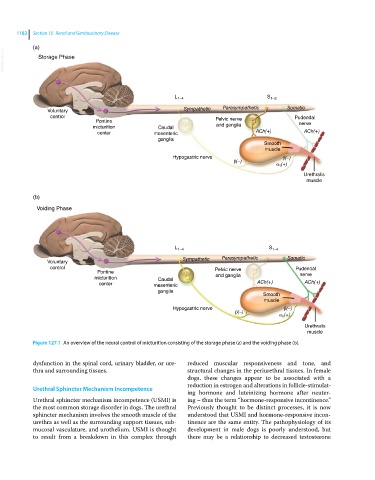Page 1244 - Clinical Small Animal Internal Medicine
P. 1244
1182 Section 10 Renal and Genitourinary Disease
(a)
VetBooks.ir Storage Phase
S
L 1–4 1–3
Voluntary Sympathetic Parasympathetic Somatic
control Pelvic nerve Pudendal
Pontine nerve
micturition Caudal and ganglia
center mesenteric ACh(+) ACh(+)
ganglia
Smooth
muscle
Hypogastric nerve (–)
(–)
(+)
1
Urethralis
muscle
(b)
Voiding Phase
L 1–4 S 1–4
Sympathetic Parasympathetic Somatic
Voluntary
control Pelvic nerve Pudendal
Pontine nerve
micturition Caudal and ganglia
center mesenteric ACh(+) ACh(+)
ganglia
Smooth
muscle
Hypogastric nerve (–)
(–)
1 (+)
Urethralis
muscle
Figure 127.1 An overview of the neural control of micturition consisting of the storage phase (a) and the voiding phase (b).
dysfunction in the spinal cord, urinary bladder, or ure reduced muscular responsiveness and tone, and
thra and surrounding tissues. structural changes in the periurethral tissues. In female
dogs, these changes appear to be associated with a
reduction in estrogen and alterations in follicle‐stimulat
Urethral Sphincter Mechanism Incompetence
ing hormone and luteinizing hormone after neuter
Urethral sphincter mechanism incompetence (USMI) is ing – thus the term “hormone‐responsive incontinence.”
the most common storage disorder in dogs. The urethral Previously thought to be distinct processes, it is now
sphincter mechanism involves the smooth muscle of the understood that USMI and hormone‐responsive incon
urethra as well as the surrounding support tissues, sub tinence are the same entity. The pathophysiology of its
mucosal vasculature, and urothelium. USMI is thought development in male dogs is poorly understood, but
to result from a breakdown in this complex through there may be a relationship to decreased testosterone

